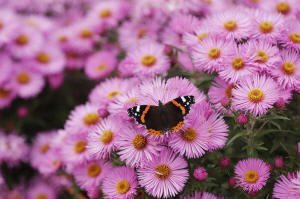First national analysis finds America's butterflies are disappearing at
'catastrophic' rate
[March 07, 2025]
By SETH BORENSTEIN
WASHINGTON (AP) — America's butterflies are disappearing because of
insecticides, climate change and habitat loss, with the number of the
winged beauties down 22% since 2000, a new study finds.
The first countrywide systematic analysis of butterfly abundance found
that the number of butterflies in the Lower 48 states has been falling
on average 1.3% a year since the turn of the century, with 114 species
showing significant declines and only nine increasing, according to a
study in Thursday's journal Science.
“Butterflies have been declining the last 20 years,” said study
co-author Nick Haddad, an entomologist at Michigan State University.
“And we don't see any sign that that's going to end."
A team of scientists combined 76,957 surveys from 35 monitoring programs
and blended them for an apples-to-apples comparison and ended up
counting 12.6 million butterflies over the decades. Last month an annual
survey that looked just at monarch butterflies, which federal officials
plan to put on the threatened species list, counted a nearly all-time
low of fewer than 10,000, down from 1.2 million in 1997.
Many of the species in decline fell by 40% or more.
‘Catastrophic and saddening’ loss over time
David Wagner, a University of Connecticut entomologist who wasn't part
of the study, praised its scope. And he said while the annual rate of
decline may not sound significant, it is “catastrophic and saddening”
when compounded over time.
“In just 30 or 40 years we are talking about losing half the butterflies
(and other insect life) over a continent!” Wagner said in an email. "The
tree of life is being denuded at unprecedented rates.”
The United States has 650 butterfly species, but 96 species were so
sparse they didn't show up in the data and another 212 species weren't
found in sufficient number to calculate trends, said study lead author
Collin Edwards, an ecologist and data scientist at the Washington
Department of Fish and Wildlife.

“I'm probably most worried about the species that couldn't even be
included in the analyses” because they were so rare, said University of
Wisconsin-Madison entomologist Karen Oberhauser, who wasn't part of the
research.
Haddad, who specializes in rare butterflies, said in recent years he has
seen just two endangered St. Francis Satyr butterflies — which only live
on a bomb range at Fort Bragg in North Carolina — “so it could be
extinct.”
Some well-known species had large drops. The red admiral, which is so
calm it lands on people, is down 44% and the American lady butterfly,
with two large eyespots on its back wings, decreased by 58%, Edwards
said.
Even the invasive white cabbage butterfly, “a species that is well
adapted to invade the world," according to Haddad, fell by 50%.
"How can that be?” Haddad wondered.

[to top of second column]
|

A red admiral butterfly stops on a New England Aster flower at the
Royal Horticultural Society Garden Wisley, in the village of Wisley,
near Woking, England, Oct. 4, 2017. (AP Photo/Matt Dunham, File)

Butterfly decline as a warning sign for humans
Cornell University butterfly expert Anurag Agrawal said he worries
most about the future of a different species: Humans.
“The loss of butterflies, parrots and porpoises is undoubtedly a bad
sign for us, the ecosystems we need and the nature we enjoy,”
Agrawal, who wasn't part of the study, said in an email. “They are
telling us that our continent's health is not doing so well ...
Butterflies are an ambassador for nature's beauty, fragility and the
interdependence of species. They have something to teach us.”
Oberhauser said butterflies connect people with nature and that
“calms us down, makes us healthier and happier and promotes
learning.”
What's happening to butterflies in the United States is probably
happening to other, less-studied insects across the continent and
world, Wagner said. He said not only is this the most comprehensive
butterfly study, but the most data-rich for any insect.
Butterflies are also pollinators, though not as prominent as bees,
and are a major source of pollination of the Texas cotton crop,
Haddad said.
Driest and warmest areas are worst for butterflies
The biggest decrease in butterflies was in the Southwest — Arizona,
New Mexico, Texas and Oklahoma — where the number of butterflies
dropped by more than half in the 20 years.
“It looks like the butterflies that are in dry and warm areas are
doing particularly poorly,” Edwards said. “And that kind of captures
a lot of the Southwest.”
Edwards said when they looked at butterfly species that lived both
in the hotter South and cooler North, the ones that did better were
in the cooler areas.
Climate change, habitat loss and insecticides tend to work together
to weaken butterfly populations, Edwards and Haddad said. Of the
three, it seems that insecticides are the biggest cause, based on
previous research from the U.S. Midwest, Haddad said.
“It makes sense because insecticide use has changed in dramatic ways
in the time since our study started,” Haddad said.
Habitats can be restored and so can butterflies, so there's hope,
Haddad said.
“You can make changes in your backyard and in your neighborhood and
in your state,” Haddad said. “That could really improve the
situation for a lot of species.”
All contents © copyright 2025 Associated Press. All rights reserved |